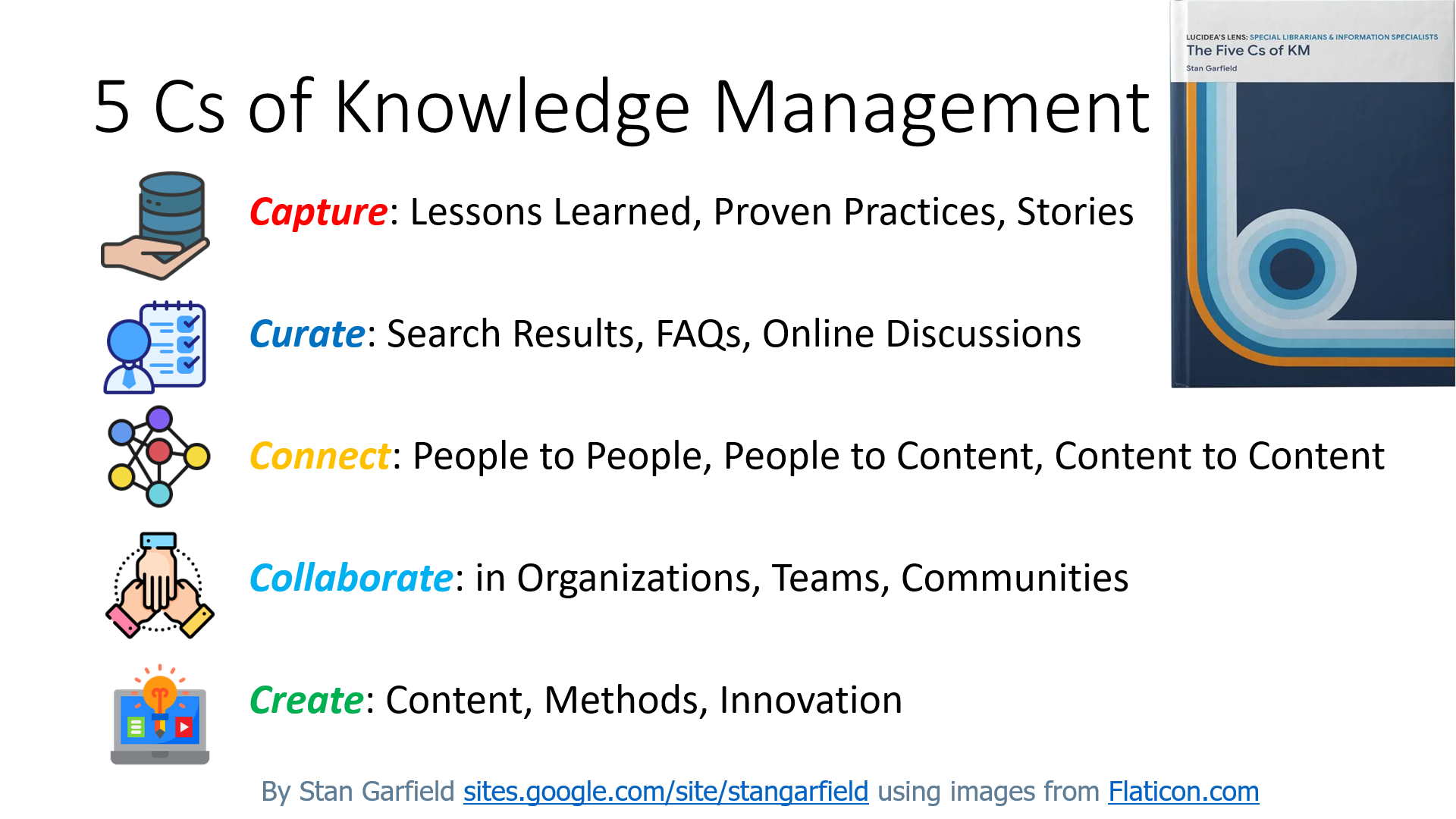Originally published Nov 27, 2022
The reactions to Four Knowledge Eras by Nancy Dixon inspired this series.
Book
Knowledge Nuggets: 100 KM Infographics

Fundamentals
4. The Knowledge Management SIRCL: Share, Innovate, Reuse, Collaborate, Learn

5. 15 Benefits of Knowledge Management

41. 5 Reasons KM Programs Start and 5 Reasons They End

42. 10 Actions Leaders Can Take to Get KM Going

30. Future of KM — 5 Foundations and 15 Fundamentals

36. 10 Trends in Knowledge Management

37. 10 Ways to Do Digital Transformation with Knowledge Management

38. 10 Signs that Knowledge Management is Alive

39. 15 Key Issues in Knowledge Management

40. 10 Roles Needed for a KM Program

43. 12 Indicators of an Ideal Knowledge Library

12 Steps to KM Success
3. 12 Steps to Knowledge Management Success

6. Step 1: 10 Ways to Build Expertise in Knowledge Management

7. Step 2: How to Identify the Top 3 Objectives for a KM Program

8. Step 3: The 10 Commitments from Senior Leaders: Securing Support for a KM Program



11. Step 6: Define the Knowledge Management Strategy: 10 Types of KM Strategies

12. Step 7: Define compelling use cases with clear advantages over existing alternatives

13. Step 8: Define KM program governance

14. Step 9: Specify the desired modes of knowledge flow

15. Step 10a: Select and implement KM people components

16. Step 10b: Select and implement KM process components

17. Step 10c: Select and implement KM technology components

18. Step 10d: Knowledge Management Implementation

19: Step 11a: 10 ways to innovate key KM processes and tools to implement a KM strategy

20: Step 11b: 10 Steps to Implement, Improve, and Iterate a knowledge management program

21: Step 12a: 10 Ways to Pay it Forward in KM

22. Step 12b: 5 Ways to Get KM Feedback and Ideas to Reuse

23. Step 12c: 10 Questions to Ask on a Resource Survey

Tips, Tricks, and Techniques
25. 10 Tips for Starting a Knowledge Management Program

27. 10 Priorities for a Knowledge Management Program

44. 7 Habits of Highly Successful Knowledge Managers

45. 10 Lessons Learned: Practical Advice for KM Leaders

46. 13 Insights on Knowledge Management

47. 10 Ways to Establish the Value of KM

48. 15 Ways to Sell KM in an Organization

109. 5 Types of Executive Responses to Knowledge Management

49. 10 Ways to Create New Knowledge

110. 10 KM Components for Knowledge Curation

111. 10 Ways to Curate Knowledge

50. 10 Ways to Retain Organizational Knowledge

51. 12 Tips for Building a Partnership Between KM and IT

52. 10 Indicators of a Knowledge Sharing Culture

53. 10 Guidelines for Collaborative Team Spaces

54. 15 Types of Knowledge Sharing


56. 10 Ways to Encourage Reuse

57. 10 Ways to Enable Lessons Learned

58. 5 Steps to Implement Taxonomy

59. 10 Ways to Provide Best Bets for Search

60. 16 Recommended Knowledge Management Books

102. Recommended Blogs, Conferences, and Podcasts

103. Recommended CoPs, Universities, and Mentoring

61. 6 Questions to Answer for Personal Knowledge Management

62. 24 Ways Artificial Intelligence Supports Knowledge Management

63. Guidelines for Knowledge Management Metrics

64. How to Motivate Knowledge Sharing

115. 16 KM Methodologies

Maxims
28. 16 Reasons Why People Don’t Share Their Knowledge

29. 10 Reasons to Share Your Knowledge

65. 12 Keys to Great Leadership: PATHBUILDERS

119: 10 Ways to Be a Great Leader: LEADERSHIP





70. 40 Pitfalls to Avoid in Knowledge Management, Part 1

71. 40 Pitfalls to Avoid in Knowledge Management, Part 2

72. 40 Pitfalls to Avoid in Knowledge Management, Part 3

73. 40 Pitfalls to Avoid in Knowledge Management, Part 4

74. 40 Pitfalls to Avoid in Knowledge Management, Part 5

26. 5 Pitfalls to Avoid in Knowledge Management

104: 10 Causes of Lost Knowledge

105: 10 Ways to Keep Content Accessible

108. 16 Suggestions from a Pragmatic KM Curmudgeon

120. HACK: Helpful Acronyms Compile Knowledge

Communication and Collaboration
75. 10 Ways to Communicate Without Pushing Content

76. 10 Tips for Successful Face-to-Face Meetings

77. 10 Questions to Ask Before Replying in Email


79. How to Build Your Personal Digital Brand

80. 10 Questions for Eliciting Success Stories


82. 10 Rules for Asking Others to Share Knowledge

83. 13 Use Cases for Collaboration

84. 8 Reasons for Working Out Loud

85. People Connections: 10 Types and 10 Attributes

86. 10 Course Details for a KM Training Plan

87. 5 Types of KM Documentation


112. Why People Won’t Ask Questions Openly and Why They Should

113. 10 Benefits of Asking Questions

114. 10 Ways to Use Questions and Answers

Communities and Networks
2. 10 Principles for Successful Communities

89. TARGETs for Community Management

90. 5 Types of Communities — TRAIL

91. 5 Activities for Community Participation — SPACE

92. 5 Requirements for Thriving Communities — SMILE

93. 5 Goals for a Communities Program — PATCH

94. 5 Expectations for Community Leaders — SHAPE

95. 5 Tools for Communities — SCENT

24. 10 Tips for Leading Communities

96. 10 Goals for Community Managers

97. 10 Tips for Managing Community Calls

98. 10 Reasons People Won’t Speak Up on Community Calls

99. Community Culture: 6 Types and 5 Recommendations

100. 10 Elements of a Practical Community Culture

101: Reviewing and Approving Requests for Communities

106. 10 Ways to Use AI in Communities

116. ESN (Enterprise Social Network) Platforms

117. Community Platforms: 8 Criteria and 50 Products

118. Virtual Meeting Platforms


31. The 5 Cs of KM, Number 1: Capture

32. The 5 Cs of KM, Number 2: Curate

The Five Cs of KM: Curate, Part 1 — Search Results
Originally posted 23-Feb-23
stangarfield.medium.com
33. The 5 Cs of KM, Number 3: Connect

34. The 5 Cs of KM, Number 4: Collaborate

The Five Cs of KM: Collaborate, Part 1 — Use Cases
Originally posted 20-Apr-23
stangarfield.medium.com
35. The 5 Cs of KM, Number 5: Create

107. What to Look for in Knowledge Management Software: The Six Cs

